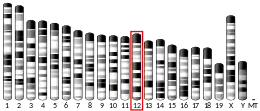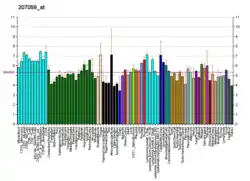PAX9
Paired box gene 9, also known as PAX9, is a protein which in humans is encoded by the PAX9 gene.[5][6] It is also found in other mammals.[7]
Expression and function
This gene is a member of the paired box (PAX) family of transcription factors. During mouse embryogenesis Pax9 expression starts from embryonic day 8.5 and becomes more evident by E9.5; at this stage its expression is restricted to the pharyngeal endoderm.[8][9] Later on, Pax9 is also expressed in the axial skeleton.[8] Pax9 is required for craniofacial, tooth and limb development,[7][8] and may more generally involve development of stratified squamous epithelia as well as various organs and skeletal elements.[5] PAX9 plays a role in the absence of wisdom teeth in some human populations (possibly along with the less well studied AXIN2 and MSX1).[7]
Clinical significance
This gene was found amplified in lung cancer. The amplification covers three tissue developmental genes - TTF1, NKX2-8, and PAX9.[10] It appears that certain lung cancer cells select for DNA copy number amplification and increased RNA/protein expression of these three coamplified genes for functional advantages.
Oligodontia
Oligodontia is a genetic disorder caused by the mutation of the PAX9 gene. This disorder results in the congenital absence of 6 or more permanent teeth, with the exception of the third molar.[11] Also known as selective tooth agenesis (STHAG), it is the most common disorder in regard to human dentition, affecting a little less than one fourth of the population.[11] The gene PAX9 which can be found on chromosome 14 encodes a group of transcription factors that play an important role in early tooth development.[12] In humans, a frameshift mutation in the paired domain of PAX9 was discovered in those affected with oligodontia.[13] Multiple mechanisms are possible by which the mutation may arise. Recently, a study involving the missense mutation of a PAX9 gene suggests that the loss of function due to the absence DNA binding domain is a mechanism that causes oligodontia.[14] Those who express the PAX9 mutation and develop the disorder continue to have a normal life expectancy. Along with the mutation of the PAX9 gene, MSX1 gene mutations have also shown to affect dental development in fetuses.[14]
References
- GRCh38: Ensembl release 89: ENSG00000198807 - Ensembl, May 2017
- GRCm38: Ensembl release 89: ENSMUSG00000001497 - Ensembl, May 2017
- "Human PubMed Reference:". National Center for Biotechnology Information, U.S. National Library of Medicine.
- "Mouse PubMed Reference:". National Center for Biotechnology Information, U.S. National Library of Medicine.
- "Entrez Gene: PAX9 paired box gene 9".
- Stapleton P, Weith A, Urbánek P, Kozmik Z, Busslinger M (April 1993). "Chromosomal localization of seven PAX genes and cloning of a novel family member, PAX-9". Nature Genetics. 3 (4): 292–8. doi:10.1038/ng0493-292. PMID 7981748. S2CID 21338655.
- Pereira TV, Salzano FM, Mostowska A, Trzeciak WH, Ruiz-Linares A, Chies JA, Saavedra C, Nagamachi C, Hurtado AM, Hill K, Castro-de-Guerra D, Silva-Júnior WA, Bortolini MC (April 2006). "Natural selection and molecular evolution in primate PAX9 gene, a major determinant of tooth development". Proceedings of the National Academy of Sciences of the United States of America. 103 (15): 5676–81. Bibcode:2006PNAS..103.5676P. doi:10.1073/pnas.0509562103. PMC 1458632. PMID 16585527.
- Peters H, Neubüser A, Kratochwil K, Balling R (September 1998). "Pax9-deficient mice lack pharyngeal pouch derivatives and teeth and exhibit craniofacial and limb abnormalities". Genes & Development. 12 (17): 2735–47. doi:10.1101/gad.12.17.2735. PMC 317134. PMID 9732271.
- Neubüser A, Koseki H, Balling R (August 1995). "Characterization and developmental expression of Pax9, a paired-box-containing gene related to Pax1". Developmental Biology. 170 (2): 701–16. doi:10.1006/dbio.1995.1248. PMID 7649395.
- Kendall J, Liu Q, Bakleh A, Krasnitz A, Nguyen KC, Lakshmi B, Gerald WL, Powers S, Mu D (October 2007). "Oncogenic cooperation and coamplification of developmental transcription factor genes in lung cancer" (PDF). Proceedings of the National Academy of Sciences of the United States of America. 104 (42): 16663–8. Bibcode:2007PNAS..10416663K. doi:10.1073/pnas.0708286104. PMC 2034240. PMID 17925434.
- Stockton DW, Das P, Goldenberg M, D'Souza RN, Patel PI (January 2000). "Mutation of PAX9 is associated with oligodontia". Nature Genetics. 24 (1): 18–9. doi:10.1038/71634. PMID 10615120. S2CID 27526349.
- Chi N, Epstein JA (January 2002). "Getting your Pax straight: Pax proteins in development and disease". Trends in Genetics. 18 (1): 41–7. doi:10.1016/s0168-9525(01)02594-x. PMID 11750700.
- Klein ML, Nieminen P, Lammi L, Niebuhr E, Kreiborg S (January 2005). "Novel mutation of the initiation codon of PAX9 causes oligodontia". Journal of Dental Research. 84 (1): 43–7. doi:10.1177/154405910508400107. PMID 15615874. S2CID 31928079.
- Jumlongras D, Lin JY, Chapra A, Seidman CE, Seidman JG, Maas RL, Olsen BR (February 2004). "A novel missense mutation in the paired domain of PAX9 causes non-syndromic oligodontia". Human Genetics. 114 (3): 242–9. doi:10.1007/s00439-003-1066-6. PMID 14689302. S2CID 12537564.
- Tan K, Shaw AL, Madsen B, Jensen K, Taylor-Papadimitriou J, Freemont PS (June 2003). "Human PLU-1 Has transcriptional repression properties and interacts with the developmental transcription factors BF-1 and PAX9". The Journal of Biological Chemistry. 278 (23): 20507–13. doi:10.1074/jbc.M301994200. PMID 12657635.
Further reading
- Kobielak A, Kobielak K, Wiśniewski AS, Mostowska A, Biedziak B, Trzeciak WH (2001). "The novel polymorphic variants within the paired box of the PAX9 gene are associated with selective tooth agenesis". Folia Histochemica et Cytobiologica. 39 (2): 111–2. PMID 11374781.
- Bannykh SI, Emery SC, Gerber JK, Jones KL, Benirschke K, Masliah E (July 2003). "Aberrant Pax1 and Pax9 expression in Jarcho-Levin syndrome: report of two Caucasian siblings and literature review". American Journal of Medical Genetics. Part A. 120A (2): 241–6. doi:10.1002/ajmg.a.20192. PMID 12833407. S2CID 1145497.
- Peters H, Schuster G, Neubüser A, Richter T, Höfler H, Balling R (January 1997). "Isolation of the Pax9 cDNA from adult human esophagus". Mammalian Genome. 8 (1): 62–4. doi:10.1007/s003359900351. PMID 9021154. S2CID 26099337.
- Stockton DW, Das P, Goldenberg M, D'Souza RN, Patel PI (January 2000). "Mutation of PAX9 is associated with oligodontia". Nature Genetics. 24 (1): 18–9. doi:10.1038/71634. PMID 10615120. S2CID 27526349.
- Hetzer-Egger C, Schorpp M, Boehm T (July 2000). "Evolutionary conservation of gene structures of the Pax1/9 gene family". Biochimica et Biophysica Acta (BBA) - Gene Structure and Expression. 1492 (2–3): 517–21. doi:10.1016/s0167-4781(00)00130-5. PMID 10899593.
- Nieminen P, Arte S, Tanner D, Paulin L, Alaluusua S, Thesleff I, Pirinen S (October 2001). "Identification of a nonsense mutation in the PAX9 gene in molar oligodontia". European Journal of Human Genetics. 9 (10): 743–6. doi:10.1038/sj.ejhg.5200715. PMID 11781684.
- Das P, Stockton DW, Bauer C, Shaffer LG, D'Souza RN, Wright T, Patel PI (April 2002). "Haploinsufficiency of PAX9 is associated with autosomal dominant hypodontia". Human Genetics. 110 (4): 371–6. doi:10.1007/s00439-002-0699-1. PMID 11941488. S2CID 8452.
- Ikegawa S, Mabuchi A, Ogawa M, Ikeda T (June 2002). "Allele-specific PCR amplification due to sequence identity between a PCR primer and an amplicon: is direct sequencing so reliable?". Human Genetics. 110 (6): 606–8. doi:10.1007/s00439-002-0735-1. PMID 12107448. S2CID 34993937.
- Gerber JK, Richter T, Kremmer E, Adamski J, Höfler H, Balling R, Peters H (July 2002). "Progressive loss of PAX9 expression correlates with increasing malignancy of dysplastic and cancerous epithelium of the human oesophagus". The Journal of Pathology. 197 (3): 293–7. doi:10.1002/path.1115. PMID 12115874.
- Peck S, Peck L, Kataja M (December 2002). "Concomitant occurrence of canine malposition and tooth agenesis: evidence of orofacial genetic fields". American Journal of Orthodontics and Dentofacial Orthopedics. 122 (6): 657–60. doi:10.1067/mod.2002.129915. PMID 12490878.
- Mostowska A, Kobielak A, Biedziak B, Trzeciak WH (June 2003). "Novel mutation in the paired box sequence of PAX9 gene in a sporadic form of oligodontia". European Journal of Oral Sciences. 111 (3): 272–6. doi:10.1034/j.1600-0722.2003.00036.x. PMID 12786960.
- Lammi L, Halonen K, Pirinen S, Thesleff I, Arte S, Nieminen P (November 2003). "A missense mutation in PAX9 in a family with distinct phenotype of oligodontia". European Journal of Human Genetics. 11 (11): 866–71. doi:10.1038/sj.ejhg.5201060. PMID 14571272.
- Mensah JK, Ogawa T, Kapadia H, Cavender AC, D'Souza RN (February 2004). "Functional analysis of a mutation in PAX9 associated with familial tooth agenesis in humans". The Journal of Biological Chemistry. 279 (7): 5924–33. doi:10.1074/jbc.M305648200. PMID 14607846.
External links
- PAX9+protein,+human at the US National Library of Medicine Medical Subject Headings (MeSH)
This article incorporates text from the United States National Library of Medicine, which is in the public domain.




